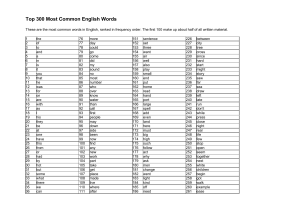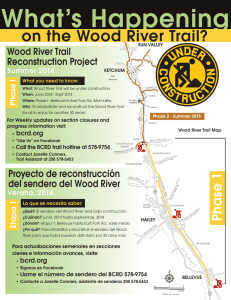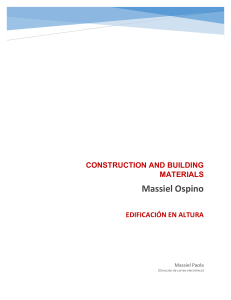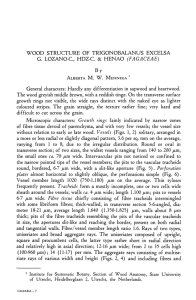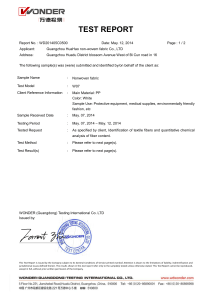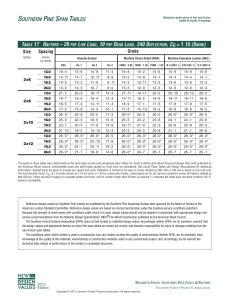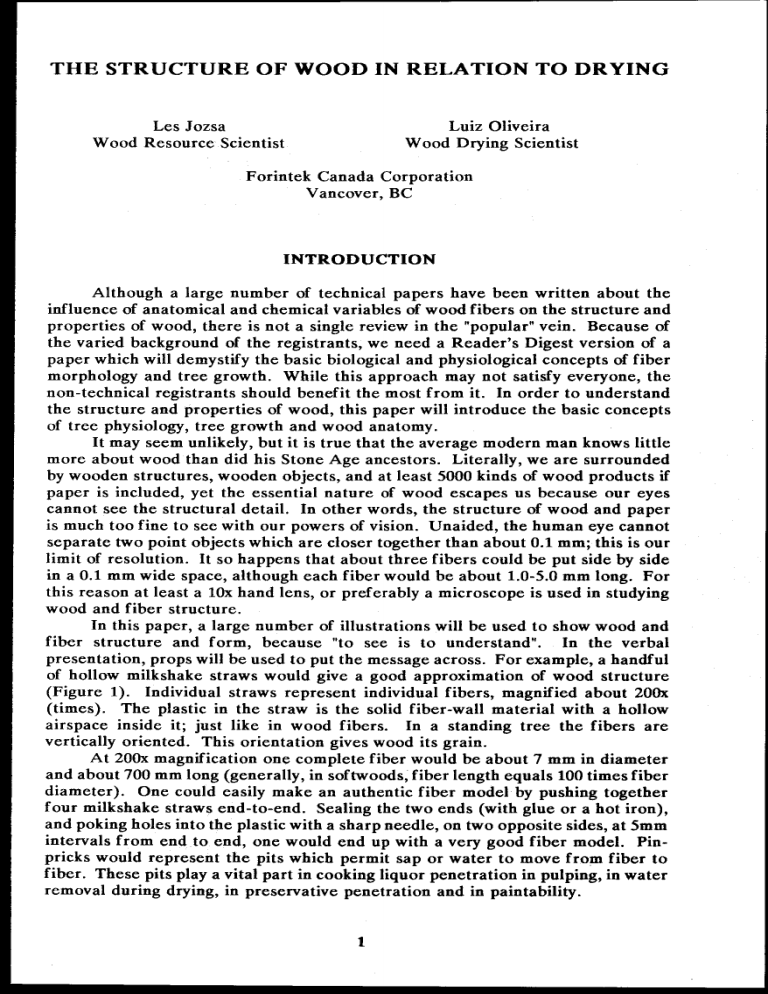
THE STRUCTURE OF WOOD IN RELATION TO DRYING Luiz Oliveira Wood Drying Scientist Les Jozsa Wood Resource Scientist Forintek Canada Corporation Vancover, BC INTRODUCTION Although a large number of technical papers have been written about the influence of anatomical and chemical variables of wood fibers on the structure and properties of wood, there is not a single review in the "popular" vein. Because of the varied background of the registrants, we need a Reader's Digest version of a paper which will demystify the basic biological and physiological concepts of fiber morphology and tree growth. While this approach may not satisfy everyone, the non-technical registrants should benefit the most from it. In order to understand the structure and properties of wood, this paper will introduce the basic concepts of tree physiology, tree growth and wood anatomy. It may seem unlikely, but it is true that the average modern man knows little more about wood than did his Stone Age ancestors. Literally, we are surrounded by wooden structures, wooden objects, and at least 5000 kinds of wood products if paper is included, yet the essential nature of wood escapes us because our eyes cannot see the structural detail. In other words, the structure of wood and paper is much too fine to see with our powers of vision. Unaided, the human eye cannot separate two point objects which are closer together than about 0.1 mm; this is our limit of resolution. It so happens that about three fibers could be put side by side in a 0.1 mm wide space, although each fiber would be about 1.0-5.0 mm long. For this reason at least a 10x hand lens, or preferably a microscope is used in studying wood and fiber structure. In this paper, a large number of illustrations will be used to show wood and fiber structure and form, because "to see is to understand". In the verbal presentation, props will be used to put the message across. For example, a handful of hollow milkshake straws would give a good approximation of wood structure (Figure 1). Individual straws represent individual fibers, magnified about 200x (times). The plastic in the straw is the solid fiber-wall material with a hollow airspace inside it; just like in wood fibers. In a standing tree the fibers are vertically oriented. This orientation gives wood its grain. At 20th magnification one complete fiber would be about 7 mm in diameter and about 700 mm long (generally, in softwoods, fiber length equals 100 times fiber diameter). One could easily make an authentic fiber model by pushing together four milkshake straws end-to-end. Sealing the two ends (with glue or a hot iron), and poking holes into the plastic with a sharp needle, on two opposite sides, at 5mm intervals from end to end, one would end up with a very good fiber model. Pinpricks would represent the pits which permit sap or water to move from fiber to fiber. These pits play a vital part in cooking liquor penetration in pulping, in water removal during drying, in preservative penetration and in paintability. 1 Cross section of single Douglas-fir growth ring at medium magnification (260 x) Figure 1. A handful of milkshake straws illustrating the cellular structure of wood at about 200X (times) magnification It would be easy to gloss over the concept of 20th magnification unless we consider the blown-up version of a one inch cube, or a more familiar piece of twoby-four lumber. The one inch cube would measure about 17 x 17 x 17 feet (5 x 5 x 5 m in metric). Into this space we could put about 5,000,000 milkshake-straw fibers (each 7 mm thick and 700 mm long). And what about the eight feet long 2 x 4 lumber? At 20th it would measure about 26 feet (8 m) high, 58 feet (18 m) wide, and 1,600 feet (490 m) long; that is, 2.5 stories high, the width of a generous Vancouver City lot, and 2.5 city blocks long (or 13 city lots laid end-to-end as shown in Figure 2)! About 2.5 billion fibers occupy this volume, side by side, aligned along the long axis. But the reason we are here is because wood is also a raw material that feeds our forest products industry. Without wood we could not have a pulp and paper industry, although, most likely the first papermaker was a wasp millions of years ago. To this day, the wasp papermakers chew off wood fibers, mix them with saliva and spread out the mixture in continuous sheets to build their nests. The human papermaker uses chemical and mechanical pulping processes to reduce wood to pulp, which is composed of individual fibers. Paper manufacturing utilizes pulps by suspending fibers in water, beating or refining the pulp, introducing additives (like fillers and wet-strength binders,) forming a fiber mat, draining the water, and drying the sheet. Before getting down to the business at hand, that is, fiber morphology, we will consider the source of the fibers. In our case, the fiber source is mainly softwoods. This paper will introduce the basic concepts of tree growth, wood anatomy, wood quality, relative density, and the structure and main chemical contents of the wood fiber wall. Finally, moisture content, moisture movement, and factors affecting wood drying will be discussed. PRINCIPLES OF TREE GROWTH AND WOOD ANATOMY A stem in cross-section reveals various layers of tissue, the most obvious being the wood portion with concentric annual rings (Figure 3). The bark is the outer protective layer and it is composed of two layers. One, the inner living bark, which is composed of conducting and storage cells. Two, the outer dead bark is a collection of dead cells which originally existed in the inner living bark. The principal function of the outer dead bark is preventing the living tissues from drying out (along the same lines as -a cork in a wine bottle). Perhaps the least obvious layer of tissue is the most important, which is the cambium. It is a thin layer of tissue between the inner bark and the wood, as shown in Figure 3. This is where wood fibers are produced by the tree through cell division. The sapwood portion of the tree is physiologically active and it is in continuous communication with the cambium and the inner living bark. The sapwood acts as a food and water storage reservoir and provides the function of sap conduction. Heartwood can be found usually at the center portion of mature stems. At one time heartwood was sapwood, but it no longer functions physiologically, its cells are dead. Heartwood is usually darker in color than the sapwood because of resinous organic deposits (extractives). Such deposits make moisture movement in kiln drying, preservative uptake in pressure treating (to improve decay resistance), and liquor penetration in the pulping stage more difficult in heartwood than in sapwood. 3 Figure 2. Approximate dimensions of an eight feet long two-by-four enlarged 200 times. House and city lot were drawn to scale to show the enormity of such magnification. Note the human figure upper left, holding a single fibre. The bottom half of the drawing shows 13 city lots end-to-end. Figure 3. Major tissue types in a tree cross section, and the principal driving forces of tree growth and annual ring formation. Although the crown of a tree is both the source of nutrients and the regulating center for wood production, wood is not produced directly by photosynthesis. Rather, wood results from successive divisions of the vascular cambium, using energy derived from the products of photosynthesis. After cambial division each successive cell undergoes enlargement, wall thickening, and lignification. The rate of cell division and final size are both thought to be largely influenced by growth regulating hormones. Active cambial division begins at the time of bud burst (flushing). At this time, usually in mid-May to mid-June in Canada, buds break their scales and reveal their green needles. Low density earlywood is produced from this time until about mid-July, when the cessation of leader growth and the maturation of new needles takes place (Figure 3). About mid-July the new foliage ceases to be a net sink of photosynthate and becomes an exporter; thus more material becomes available for wall thickening. Also, the reduced crown activity limits auxin production, which helps trigger high density latewood formation. Thus, the active growing season lasts about four months until about mid-September, when the lower temperatures and the reduced photoperiod bring on tree dormancy. In summary, the growing tree forms large diameter, thin-walled fibers in the early part of the growing season (springwood or earlywood), and smaller diameter thick-walled fibers during the latter part (summerwood or latewood). Collectively, these fibers form an annual ring. Radial growth begins first near the top of the tree and proceeds gradually downward in the stem, resulting in more springwood and wider rings near the pith in the upper crown region. Transition to summerwood occurs first near the base, farthest from the source of auxin supply, and proceeds upwards. Therefore, the density of an individual fiber is determined by its relative position, that is, its distance from the active live crown region, and by the time of its formation. The relative density of most commercially important Canadian softwoods ranges from about 0.2 in the springwood to about 1.0 in the summerwood. The average relative density of the different softwood species ranging from about 0.3 for western red cedar to 0.55 for Douglas-fir and western larch, largely dictated by the proportion of the low density springwood and high density summerwood in the annual rings. WOOD QUALITY CONSIDERATIONS Wood produced by trees of the same species is often thought to be identical in all structural and physical characteristics. In reality, different pieces of wood even from the same tree are never identical and are similar only within broad limits. Dimensional and physical characteristics (such as ring width, percent summerwood width, relative density, fiber length, moisture content, etc.) within trees are variable and they exhibit a range of values. The variations can be related to the radial (pith-to-bark) or axial (base to top of stem) position of the sample within the tree. The dimensional and physical variables in wood are influenced by the following factors: Cambial age; 1. Genetic controls that govern the form and growth of the tree; and 2. Environment influences, such as climate, geology and nutrient supply. 3. 6 Because of the interactions of these influences, it is difficult to ascribe variability in tree rings to a single factor or even to a combination of factors affecting tree growth. Yet it is safe to say that the cambial age has the greatest impact in terms of wood quality variability. For example, in case of fiber length, there can be a 200300 percent difference within a single tree attributable to cambial age. Wood quality is linked to end-use requirements, which are stipulated through grades, specifications, and code regulations. Density is generally considered to be the single most important indicator of clear wood quality and suitability for pulp and paper. It is the primary determinant of clear wood strength and yield of pulp per unit wood volume. It is also related to heat per unit volume produced during combustion, to shrinkage and swelling, to heat transmission, to machining and to other properties. Unfortunately, density is difficult to measure on a small scale (like individual annual rings) by conventional methods. For this reason x-ray densitometry is used for measuring the relative density of wood for assessing wood quality. SOURCES OF RELATIVE DENSITY VARIATION IN WOOD The relative density variation of wood can be discussed from a variety of perspectives, starting with species average and range, tree-to-tree differences in the stand, within tree trends from pith-to-bark and from base to the top of the stem, and within annual ring variability. Figure 4 illustrates this variety, ranging from the macroscopic to the microscopic perspective. For example, the "global perspective" of relative distribution is shown for Douglas-fir in Figure 4a. This bell-curve approximation includes all Douglas-fir trees from British Columbia (Coastal and Interior), Washington, Oregon, California, Europe, New Zealand, and elsewhere. One would expect a normal distribution with the mean between 0.45 and 0.50 (on ovendry basis), flanked by the extreme lows and highs in the 0.3s and 0.6s, respectively. The expected tree-to-tree relative density differences in the stand are illustrated in Figure 4b. If one were to sample 10 dominant and codominant trees in a stand and determine the average stemwood relative density, one would expect a certain difference between the least and the most dense trees. In this example (Figure 4b) the stemwood relative densities range from 0.40 to 0.55. Of course, a greater number of trees would most likely provide a wider range. These tree-totree differences in the stand are thought to be mainly genetic in origin. The biological tree-age component is shown in Figure 4c. In previous work at Forintek average yearly density trends were examined from pith-to-bark at several sampling heights in Douglas-fir. The results indicated relatively low density juvenile wood in Douglas-fir (about 0.46) for the first 15 to 20 years of growth. Then a rapid increase was evident to about age 30, followed by a stable or slightly increasing density trend in the outer mature wood, whose average density was about 0.53. Similar trends were observed by other workers in western hemlock, Douglasfir and in some pine species as well. Other species have vastly different pith-tobark trends, and forest products technologists and papermakers should have a better understanding of this phenomenon. Within annual ring density variation is illustrated in Figure 4d. Between low density springwood (earlywood) and high density summerwood (latewood) the differences are about four-fold, from about 0.25 to 1.00. These differences were 7 oo sown • SZNIANII MCP INS.M.11101•0 =OA or0 000 ui Figure 4. Sources of relative density variation in Douglas-fir from a variety of perspectives: a. Global; b. Tree-to-tree; c. Within a cross section; d. Within an annual ring; e. Within individual fibre walls and lumina (solids and voids). attributed in the above discussion to growth-regulating hormones. However, springwood and summerwood production in a tree is seasonally driven, and higher density woods have greater proportion of thick-walled summerwood fibers. Interestingly, the greatest density difference can be observed for any species on the microscopic level, between the lumen (hollow airspace inside the fiber) and the fiber wall (solid wood substance). This concept is illustrated in Figure 4e. The relative density of the solid wood substance in the fiber wall is about 1.53 on ovendry basis (green 1.1), regardless of fiber wall thickness, and regardless of species. Therefore, it is the proportion of solids in the fiber wall and the voids in the fiber cavities (lumen) that determines wood relative density. Western red cedar has the same solid wood substance density as Douglas-fir, but western red cedar has move voids, therefore it has lower average density than Douglas-fir (about 0.33 compared with 0.48). It may seem incredible but the average relative density of the springwood is almost identical for western red cedar and Douglas-fir, about 0.30. The big difference in species average relative densities has to do with the proportion of summer-wood in the annual ring. Typically, Douglas-fir annual ring is composed of 30 to 50 percent summerwood on a width basis. For western red cedar about 10 percent summerwood is the norm. The average relative density of the summerwood is about 0.70 for Douglas-fir, and about 0.60 for western red cedar. Interestingly, in a study at Forintek on 15 softwood species, the average springwood relative density ranged from about 0.3 to 0.4, and the summerwood density from 0.53 to 0.70. Percent latewood ranged from 9 to 62 percent. Within annual ring minimum-maximum density range was about 0.15 to 1.00 (to put the last two numbers in perspective, they represent the relative density of balsa wood and rosewood, respectively). In summary, the average relative density of all commercially important softwoods in Canada is about 0.4 because of the airspaces inside the "milkshake straws". This is the reason why wood floats in water. If we were to fill up the fiber cavities with water the wood will sink. In fact this is what happens with "deadheads", or waterlogged wood. The ultimate maximum density of wood, with no airspaces is 1.53. According to the Guiness Book of Records the most dense wood is ironwood at 1.42, and the least dense wood is pith wood at 0.04 (this is one quarter of balsa wood whose density is about 0.16). Although a high relative density is desirable in the solid wood products sector (and from the pulping -yield point of view), it is not a very desirable property from the papermaking point of view. MICROSCOPIC STRUCTURE OF WOOD Wood is an anisotropic material, which means that it has different properties when viewed in different directions. Because of the arrangement of growth rings in the tree, as well as the horizontal and vertical orientation of the individual cells, it is appropriate to consider the structure of wood in three-dimensional terms. Therefore, normally wood is examined in three planes: cross (transverse), tangential and radial. This concept is illustrated in Figure 5a at about 400x magnification. The top surface of this small cube represents the cross-sectional surface, the left-hand front surface is the tangential plane, and the right-hand front surface corresponds to the radial plane. About 95 percent of the volume of wood is occupied by fibers (millshake straws) which are oriented in the vertical direction. 9 b (1* lodgepole pine O western spruce western white pine western red cedar true fir ( Abies ) western hemlock Figure 5. The three-dimensional structure of wood: a. Sketch of a small cube at about 400X magnification; b. Springwood fibre segments showing typical arrangement of ray cross-field pits and bordered pits on the radial surface of each fibre (500X). The remainder is mostly horizontally aligned ray tissue, although some species also have a small percentage of epithelial cells of little practical consequence. The epithelial cells are similar in size to the ray cells, and after pulping they both end up mostly as fines. In Figure 5a two fibers were drawn in a telescoping fashion to bring to attention a large diameter, thin walled springwood fiber, and a small diameter, thick walled summerwood fiber. These examples show that the summerwood fibers have very few markings, whereas the springwood fibers have a lot of markings in forms of bordered pits and ray cross-field pits. The pitting occurs almost exclusively on the radial face of the fiber wall. The more frequent pitting in springwood fibers are due to the greater degree of physiological activity taking place when the springwood fibers were formed. On the average each springwood fiber has about 5 to 10 ray contact areas along its length. The shape and size of pits contained in these areas provide vital diagnostic clues in microscopic species identification. Thin, transparent sections are used for microscopic examination at the most common magnifications of 100, 250 and 40th. The ultimate ideal in the identification of wood is the complete familiarity not only with the diagnostic structures of the wood themselves but also with the degree of natural variation to be found in wood from trees of the same species. In Figure 5b individual springwood fiber segments show typical shapes and sizes of ray cross-field pits for the six most common commercial softwood species in B.C. at about 500x magnification. Douglas-fir was omitted because of the relative case of identification based on spiral thickenings (its ray cross-field pits are similar to spruce). In summary, the fiber morphology of the wood is very important because it largely controls the extent and manner to which water (in lumber drying), preservatives (in treated wood), pulping chemicals (in pulp and paper) penetrate and diffuse through wood. While chipping the log exposes greater surface area it is the capillary network and pitting between fibers and ray cells that mainly control liquor penetration. Fiber wall pitting aids in the diffusion of the chemicals into the highly lignified middle lamella, although diffusion also occurs through the fiber wall at a slower rate. Once the chemicals have reached the middle lamella delignification occurs by dissolving the lignin bond. WATER IN WOOD Wood in its natural state always contains a large amount of water. For example, the moisture content of a standing tree may range from about 35 to 200 percent. Lumber from which little or no moisture has been removed is usually referred to as green or unseasoned. The presence of moisture so influences the properties of wood that, for many purposes, the moisture must be removed to permit the wood to function and behave in an acceptable or improved manner. Some of the advantages of drying wood are: Freight charges by road and rail are based on weight, therefore, roughly speaking, green lumber containing equal weights of water and wood substance could cost twice as much to transport as dry lumber. Wood will remain dimensionally stable if it is dried to a moisture content close to that which it will reach in service. 11 With the exception of toughness and shock resistance, the strength of dry wood is greater than that of green wood. A certain amount of water (22 percent based on oven-dry weight) is necessary in wood before wood destroying organisms can cause decay. Therefore, if wood is dried to less than this level and kept dry, there will be no decay. Oil-based paint will not penetrate green wood; even paint which appears to adhere to it; will be damaged as the wood dries and shrinks. Similarly wood must be relatively dry before it can be satisfactorily glued or treated with preservatives. Wood quality is closely associated with wood drying practices, therefore it is important to understand the relationship wood-moisture and how the structure of the wood affects water movement so that better drying strategies can be proposed. Important features for water movement were illustrated in Figure 5. The same vertical fibers responsible for mechanical support to maintain a tree in its upright position, are also responsible for water transport from roots to leaves. The openings (pits) along the vertical wood fibers permit transversal water movement. In its early years, practically all of the wood in a tree will actively conduct water. As the tree ages, new wood is formed under the bark and the older wood becomes physiologically inactive near the center of the tree. This portion of the wood referred to as heartwood, ceases to transport water and becomes a storage area for extraneous materials, known as extractives. The sapwood, the newly formed wood, has the active role for moisture transport. The older the tree, the greater is the proportion of heartwood. Conversely, the younger the tree the higher proportion of sapwood it contains. The difference between sapwood and heartwood is quite important in wood drying. Usually sapwood contains much more water than heartwood. Nonetheless, it is normally more difficult to remove water from the heartwood than from the sapwood. The slower for heartwood are usually due to the presence of extractives which block up the passages for water flow. In a freshly felled log, the water is distributed in all fibers. As illustrated in Figure 6, water will be present in the fiber cavity as well as in the fiber wall. These locations of the moisture are very important in the process of water removal. Newly formed fibers are usually in a water saturated ambient and will remain in this condition as long as the primary function of transporting water from roots to leaves exists. When transporting water is no longer a primary function, the fiber becomes partially filled with water and with water vapor. Thus green wood may contain liquid water in the fiber cavities, water vapor in the fiber cavities and water in the fiber wall. The water in the fiber cavities is denoted "free water" to distinguish from the water in the fiber walls which is known as "bound water". The bound water is attracted to the wood with stronger forces than those which hold the free water. When a piece of wood starts to dry, a particular fiber wall will lose its "free water" first, since this water is held by weaker forces when compared to the bound water. Generally the fibers empty before bound water starts to move out. A certain stage is reached when the fiber cavities are empty but the fiber walls are still fully saturated. This stage is called the "fiber saturation point" (FSP) and it is when important changes in the wood properties occur. 12 Figure 6. Moisture content of heartwood and sapwood, the concept of "free water" in the fiber cavities, and "bound water" in the fiber walls. 13 WATER MOVEMENT ABOVE THE FPS Free water exists in the cavities of the fibers as long as the moisture content is above the FSP. It is generally assumed that a moisture content of 30% (dry basis) corresponds to the FSP. Free water moves longitudinally through the fibers and from one fiber to another through small apertures as illustrated in Figure 5. These passages are called bordered pits and have average diameters varying between 2 and 8 microns. Fiber diameters are about 35 microns and length up to 3,500 microns. By comparing the diameters for fiber cavity and pit aperture, it is clear that the flux of water will be much greater through the cavity than through the pit. Free water moves in response to capillary forces created by the evaporation of water from fibers near or at the surface of the wood. Permeability, which is a measure of connecting passages between wood fibers, is the most single important element during water removal above the FSP. Water flow due to capillarity is at least fifty times faster in the direction of the grain (longitudinal) than across it. Evidently movement of free water will occur only if enough free water is present and it is faster at higher moisture contents. Temperature has also a significant effect on water movement above the fiber saturation point. The viscosity of water is decreased as temperature is increased and therefore water will flow more rapidly. WATER MOVEMENT BELOW THE FSP Below the FSP it is necessary to consider the following water movement mechanisms: a) Vapor diffusion; b) Bound water diffusion and c) Combined Vapor diffusion and Bound water diffusion. In reality these three mechanisms occur simultaneously. During vapor diffusion, water molecules will move from an area with higher concentration to an area with lower concentration. The rate of diffusion is proportional to the difference in vapor pressure between two locations inside the wood. As it is expected, vapor diffusion will take place only if there is a continuous path so that vapor can move from one zone to another. In this way, vapor diffusion will only be effective in permeable wood. Bound water diffusion takes place inside the fiber wall. It is a very slow process in which water molecules move from site to site along the cellulose molecule. As with vapor diffusion, water molecules will migrate from areas with higher moisture content concentration to areas with lower water content. Although vapor concentration gradient is the force responsible for both vapor diffusion and bound water diffusion, the latter is a much slower process. During drying, vapor diffusion and bound water diffusion occur at the same time. Water molecules adsorbed by the cellulose molecule will migrate into the fiber cavity, diffuse as vapor and before reaching the surface of the wood, these water molecules may be reabsorbed by cellulose or hemicellulose within the fiber wall. Dense wood contains a higher rate of fiber wall to fiber cavity (lumen) than low density wood. As water movement through the fiber walls is a much slower process, it is expected that below the FSP low density species will dry much faster than high density species. 14 FACTORS AFFECTING DRYING Wood drying is a very complex simultaneous heat and mass transfer phenomena. It is quite possible to have moisture content above the FSP for one location of a particular piece of wood while having a moisture content below the FSP for another area of the same piece. In this way, the three forms of water movement indicated before may occur at the same time. In addition, depending on the conditions that exist in the wood, water may be converted from one form to another during its migration to the surface. Several factors influence the water movement to the surface besides the wood structure factors mentioned previously. The most important of them are: temperature, humidity and air circulation. Energy is necessary to evaporate the moisture present in the wood. It takes about 1000 BTU to evaporate a pound of water and during industrial drying as much as 50% more may be required. Higher temperatures are always desired during wood drying since water moves faster either by capillary flow or by diffusion at elevated temperatures. However, there is a temperature limit to which a certain species can be exposed to without risk of serious drying degrade. In the beginning of drying of green lumber, the temperature at the surface of the wood is the same as that of the wet-bulb temperature. As the wood dries out, its surface temperature increases continuously towards the dry-bulb temperature. Relative humidity is another important variable contributing to water movement as well as to the equilibrium moisture content of wood. The lower the relative humidity the higher is the water removal from the wood. Relative humidity in the kiln is carefully controlled throughout the drying process so that water evaporation is not excessive and drying degrade can be minimized. In addition to temperature and relative humidity, air circulation is also a very important physical element during wood drying. Air circulation is necessary to transfer heat to the wood and to remove the water evaporated away from the wood. In order to be effective, air must be circulated at a certain speeds which vary from 300 to 1000 ft/min. In the early stages of drying, when larger amounts of free water arc available, higher air velocities arc usually required. As the drying progresses and internal resistance becomes the main contributing factor for slowing down water movement, air velocities in the kiln may be substantially reduced and some energy savings may be realized. This brief discussion was intended to introduce some factors that will influence water transport in the wood and therefore affect the overall industrial drying process. An understanding of the wood structure features and how they will determine water movement is extremely important when designing drying schedules. An overall approach, taking into consideration the wood structure coupled with physical elements that can be controlled during an industrial process, represent the most efficient way to add value and to obtain a final product with a required quality. • 15
